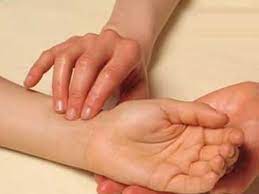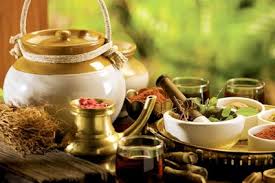SCHEDULE A CONSULTATION TODAY
Definition of the psycho-physiological type using pulse diagnosis and questionnaire. With such a simple procedure as pulse diagnosis, the specialist can determine the state of balance between you mind and body.
One of the main advantages of the pulse diagnosis is that it will allow the ayurvedic specialist to determine the existence of disbalance prior to it manifesting as an illness.
Early detection of such disbalance allows the prevention of the disease.
"Prevent the danger before it manifests"- Veda
Diet, daily routine, and certain habits often lead to a disease, if not balanced. Ayurvedic consultant will help you to identify the cause of such disproportion and will provide simple recommendations to balance the body and mind of a patient
- Daily routine
- Nutrition in accordance with the person's constitution
- Use of herbal medicine
- Physical exercise program
- Body cleansing procedures - PanchaKarma
Practical application of this knowledge enables each person to find that unique way to live a healthy and happy life.
Ayurvedic treatment is carried out using phytotherapy, which when applied appropriately will not cause side effects. Herbs have a gentle and at the same time balancing effect on the body as a whole, which allows use of herbal treatments and apply them during various manifestations of diseases.
During the consultation, the patient will understand what first caused the imbalance, and resulted in an illness.
A follow-up consultation will allow to track any changes that happened in the health of the patient.
Ayurveda, India's traditional treatment system and yoga's sister science, is believed to be available in the industry for nearly five thousand years. It is considered as the oldest constantly practiced medicine system. Before X-rays, blood tests, CAT scans, and MRIs, there existed the eightfold diagnosis process known as the ashtavidha parkisha- where "parkisha" means exam, "ashta" refers to eight, and "vidha" refers to a process or fold. This examination is still conducted today by certified Ayurvedic consultants and medical practitioners.
The checkup is a thorough procedure that helps the medical doctor to know you better. It involves examining the eight parts of your body system and the bodily features and functions, all of which show places of imbalance and balance. Most of these components are adjusted to operate throughout the virtual session through our online Ayurvedic consultations: nevertheless, much remains the same. While the pulse will not be taken, for instance, you might find yourself putting your nails on the camera or sticking out the tongue. The foundation to a comprehensive consultation is often in the inquiring, collecting a perfect image of your lifestyle and diet.
Checklist
Tongue
While examining the tongue, our specialists will look at the shape and color to see if there are scallops around the sides, cracking, coating and movement. A round-tipped, large tongue may indicate more Kapha; pointed-tip, thin and cracked, is more prone to Vata, and redness suggests Pitta. Teeth impressions suggest possible malnutrition and malabsorption. Coating suggests undigested food or the presence of ama in the digestive system.
 Pulse
Pulse
Diagnosing the pulse is a great way to check one’s dosha or constitution and current condition of imbalance. You can even choose to take our quiz to check your dosha. One of our specialists will feel for the strength of Kapha, Pitta, and Vata in your pulse. They check for the general features of the pulse as well, including light or heavy, mobile or stable, bounding or feeble, cold or hot. Vata is felt beneath the first finger, Kapha beneath the ring finger, and Pitta in the middle finger. A cold, light, dry pulse suggests the presence of Vata: a steady, soft, slow pulse is more prevalent to Kapha, and a sharp, bounding, hot pulse suggests Pitta.
Attempt sticking out the tongue every morning immediately after you wake up for an Ayurvedic self-diagnosis. Did you find any coating? If yes, what color is it? Brown indicates Vata, yellow; Pitta and white; Kapha. It is vital to eliminate this coating each morning with a metal tongue scraper. Softly scrap your tongue from the rear to the front part around three to five times. That will help to remove digestive waste and boost your gastric system.
Nails
Nails can also help to check for the presence of Kapha, Vata, and Pitta. For instance, a long vertical line may suggest malabsorption; flexible, soft nails suggest Pitta; nails that break easily indicate Vata; and Kapha condition is characterized by strong, oily, and thick nails. Also, dry skin is a characteristic of Vata. Oily skin susceptible to rashes and acne represents pitta disparity, and Kapha skin is smooth, soft, and thick.
 Eyes
Eyes
In most cases, doshas may affect both color and shape of your eyes. Dry, small eyes suggest Vata; piercing, medium, intense eyes indicate Pitta; watery, big eyes suggest Kapha. Also, yellowness and redness around the whites of your eyes may indicate Pitta. Soothing your eyes daily by splashing cold water on them and adding some amount of rosewater can help relieve tired, dry, and red eyes.
Sound in the body
Cracking joints or gurgling in your stomach can suggest the prevalence of Vata. Maintaining regular mealtimes and eating cooking foods can help to relieve the gurgling. On the other hand, using sesame oil to rub the joints can help to soothe cracking sounds. The tone, speed, and quality of your voice can also offer more information about your constitution. Those who speak very fast and tend to lose their thoughts might have Vata present in their bodies. Individuals with Pitta in their bodies speak clearly and sharply. If you speak slowly and take enough time to express your thoughts, there might be Kapha present.
General appearance
The texture and color of your hair, body type, gait, and even energy level can show the predominance of Kapha, Pitta, and Vata. A body with small, thin bones, sinewy, and without much musculature or curve indicates Vata. Pitta body types are typically medium-framed with a moderate level of musculature. On the other hand, Kapha types are bigger-boned and fuller with more pronounced curves. Kapha hair is typically wavy or curly, oily, and dark brown. Pitta types have reddish, thinner hair, auburn, or reddish and might go gray later in life. Vata hair is normally average in amount, blonde or light brown, and dry.
After examining every aspect of your body, the doctor can draw apparent conclusions about which tools you can try to balance your life. These might include pranayama and yoga techniques, food choices, self-care routines, herbs, and movement or meditation practices. The major objective of Ayurveda is to clear out the blockages in your mind, body, and senses to help you gain your greatest potential for thriving and better health.
Our Reviews
"Knowledge of Ayurveda made my life harmonious and full-fledged. For over 10 years I was trying to recover the women’s health and dreamed about having a child. Traditional treatment methods could not help me. I was lucky to meet Tetiana . In just 1.5 years, Ayurveda became my lifestyle, and very soon, I have received my long-awaited gift – a son."
A.C. -- Ft. Lauderdale, FL
Get Started With a Free 15-Minute Consultation
